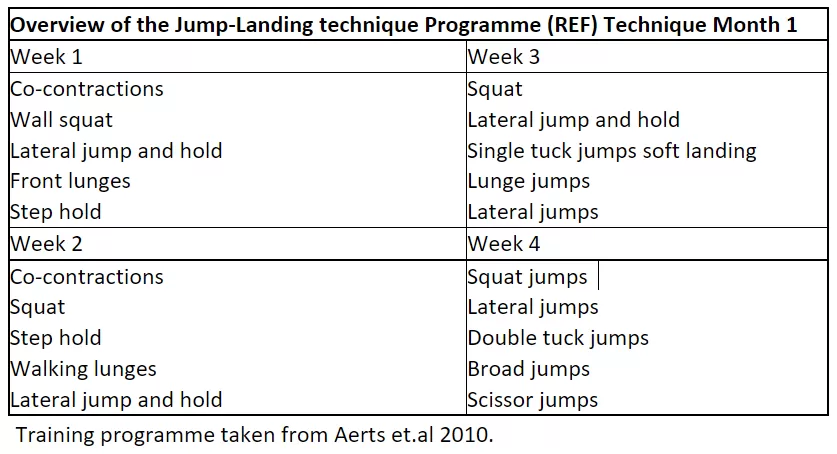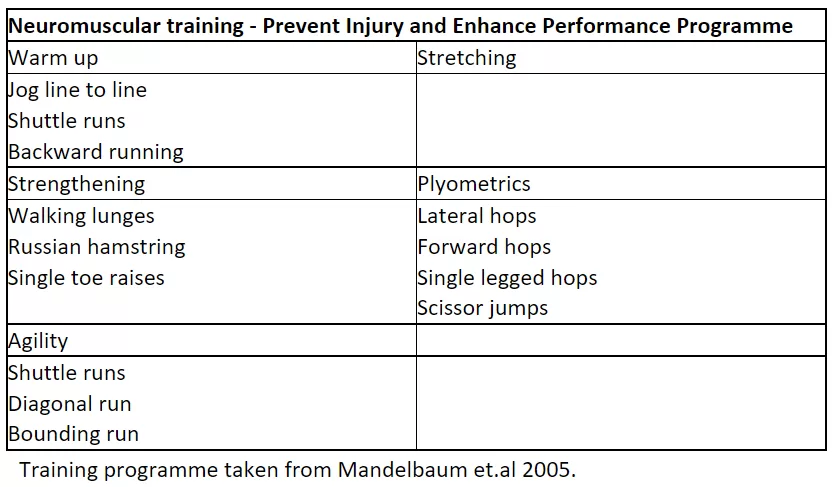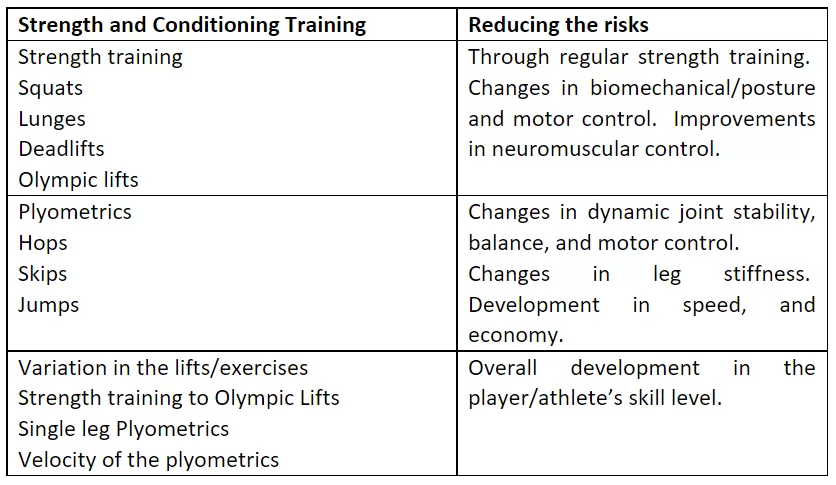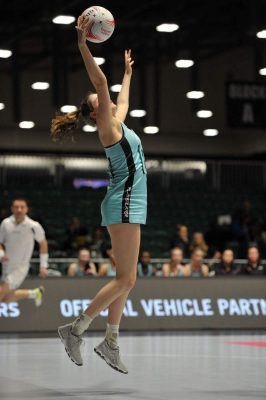In the blog Netball – The importance of Physical Preparation, I stated that a Long-term Athlete Development Programme (LTAD) comprises of:
- Strength and conditioning training and sessions
- Netball practice and competitive games
- Health and wellbeing of the player (rest, sleep, and nutrition)
- Ongoing monitoring of the player (athlete profile, tests, training data)
Additionally, within the strength and conditioning spectrum, I highlighted three main aims or objectives. 1) prepare the player for the sporting demands, 2) identify and minimise injury risks, 3) develop physical capacities which may transfer to game performances.
I still stand by this, however, I would state that aims 1 and 2 are highly integrated, especially in netball, where there seems to be a high injury risk (Ferreira & Spamer, 2010). Reviewing the reported injuries within netball, lower limb injuries seem to be at most risk, with the ankle and knees being the most frequently injured (Hume, & Steele, 2000).
Unfortunately, from a severity point of view, suffering an Anterior Cruciate Ligament (ACL) injury is both common and comes with long-term consequences. If the player completely ruptures their ACL, they will be away from their sport for at least a year (Arden, Webster, & Taylor, 2011), if not longer, and after rehabilitation/retuning back to their sport programme, the reoccurrence of injury is especially high (Kamath, Murphy, & Creighton, 2014). Therefore, applying aims 1 and 2, preparing the athlete for their sport and minimising the risks, are essential in the long-term health of each player.
We have reviewed some of the sporting demands, but just to remind you, during a game players perform hops, skips, and jumps, along with quick changes of direction, and short sprints. From an ACL stance, jumping and landing has received a lot of attention, as players must cope with high ground reaction forces on landing (6 – 8 times bodyweight (Hopper, McNair, & Elliott, 1999). Additionally, players must stick their landing, which restricts or inhibits the ability to use any elastic energy, thus the energy needs to be dissipated through the musculoskeletal structures.
When landing with stiff legs, with minimum hip and knee motion, the impact/ground reaction forces (GRF) will create a higher/condensed peak (peak force), as there’s reduced time available, whereas, bending the hips and knees on landing will flatten the curve, as the player is given more time to cope with the force. The challenge with landing with a high amount of knee and hip bend, is that it slows the player down, thus we may have a problem. What can we do to help our players perform, but also keep them healthy and playing their sport?
As with most musculoskeletal injuries, the literature will report that there’s no one causative factor, and we should view the injuries as multifactorial. However, as a strength coach, we still need to identify and list the different factors to see if we can develop qualities and/or strategies to help our players. The below table highlights the reported factors with ACL injuries.

If coaches look at these risk factors in isolation, and thus try and improve or specifically intervene, for example, by prescribing exercises to improve neuromuscular control, we inevitably fall into a trap of over-categorising a set of training or exercises.
Having reviewed some of the literature and studies, which have prescribed training to help with, or even to improve landing techniques and exercises to develop neuromuscular control (see comparative programmes below), we can clearly see that the main body of training is strength exercises and plyometric drills, which would form a large part of an LTAD programme.


Practical Application
So, by offering and delivering a LTAD model with clear strength and conditioning aims/objectives to all netball players, including young players, this will undoubtably help to reduce or even remove some of the ACL risk factors.

At the Lab, our performance centre, especially designed for young athletes, we deliver our strength and conditioning both in house and via our Athlete App, as we can prescribe a range of different training modalities, either via a block or concurrent method. Furthermore, each player can upload their training data, effort level, monitor their fatigue level, along with feedback from their strength coach.
Through delivering strength and conditioning relative to the player’s maturation, training age, and physical capacities, we can expose each player to strength training, plyometrics and sprint drills. Collectively, these modalities will drive adaptations, to improve/reduce the identified risk factors (knee valgus, neuromuscular control, dynamic joint stability, skill level and joint laxity), furthermore, each player will develop self-confidence in their physical capacities and skill, thus performing a range of self-organising landing techniques within netball practice or competitive games.
Our vision at Advance Performance is to support sport coaches and parents in the delivery of a fluid LTAD programme, minimising any barriers to strength and conditioning.
References
Aerts, I., Cumps., E., Verhagen, E., & Meeusen, R. (2010). Efficacy of a 3-month training program on the jump-landing technique in jump-landing spots. Design a cluster randomized controlled trial. BMC Musculoskeletal Disorders, 11, 1 – 8.
Ardern, C.L., Webster, K. E., & Taylor, N.F. (2011). Return to preinjury level of competition sport after anterior cruciate ligament reconstruction surgery: two-thirds of patients have not returned by 12 months after surgery. The American journal of Sports Medicine, 39(3), 538 – 543.
Ferreira, M.A., & Spamer, E, J. (2010). Biomechanical, anthropometrical, and physical profile of elite university netball players and the relationship to musculoskeletal injuries. South African Journal for Research in Sport, Physical Education and Recreation, 32(1), 57 – 67.
Hopper, D.M., McNair, P., & Elliott, B.C. (1999). Landing in netball: effects of taping and bracing the ankle. British Journal of Sports Medicine, 33, 409 – 413.
Hume, P.A., & Steele, J.R. (2000). A preliminary investigation of injury prevention strategies in netball. Are players heeding the advice? Journal of Science and Medicine in Sport, 3(4), 406 – 413.
Kamath, G.V., Murphy, T., & Creighton, R.A. (2014). Anterior cruciate ligament injury, return to play, and reinjury in the elite collegiate athlete: analysis of an NCAA division 1 cohort. The American journal of Sports Medicine, 42(7), 1638 – 1643.
Mandelbaum, B.R., Silvers, H.J., Watanabe, D.S., Knarr, J.F., Thomas, S.D., Griffin, L.Y., Kirdendall, D.T., & Garrett, W. (2005). Effectiveness of neuromuscular and proprioceptive training program in preventing anterior cruciate ligament injuries in female athletes. The American journal of Sports Medicine, 33(7), 1003 – 1010.



